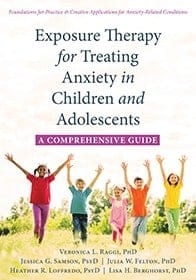Therapy
Exposure Therapy: Overview and Effectiveness
THC Editorial Team January 20, 2021

Contents
- Overview
- History of Exposure Therapy
- How Does Exposure Therapy Work?
- Effectiveness of Exposure Therapy
What Is Exposure Therapy?
Exposure therapy is an evidence-based form of therapy that allows patients to confront their fears of objects, situations, or activities that they would otherwise avoid, in order to prevent related long-term mental and behavioral consequences. Although avoidance enables people to feel short-term relief from anxiety, it prevents them from overcoming their fears. Fears associated with stimuli can build over time and may severely affect a person’s daily life.
This form of therapy is based on the idea that gradual exposure to fear stimuli can reduce anxiety and improve one’s quality of life.1 When qualified professionals oversee a client’s systematic exposure to fear stimuli, clients are able to reduce their fear and decrease avoidance of particular objects, situations, or activities.
Exposure therapy can be used to treat a variety of mental health conditions, but it works particularly well for anxiety and related disorders.2 It aims to reduce extreme and/or irrational fears by placing individuals in situations where they cannot avoid their feared stimuli. During this form of therapy, people may be placed in real-life scenarios or mentally imagined situations or may be asked to recount instances of trauma. Individuals then learn effective, healthy coping strategies from practitioners in order to avoid resorting to maladaptive behavior such as avoidance, substance abuse, or aggression.3
What Is the History of Exposure Therapy?
In the early 1900s, Russian physiologist Ivan Pavlov discovered that individuals could learn new behaviors through classical conditioning, a type of associative learning in which a behavior is paired with a certain stimulus.4 Exposure therapy is closely related to classical conditioning and was first used in the 1920s by American developmental psychologist Mary Cover Jones to help treat a client’s fear of rabbits.5
Later, in 1958, South African psychiatrist Joseph Wolpe built on the foundations of exposure therapy by creating a technique called systematic desensitization. In this form of exposure therapy, individuals learn and then use relaxation techniques as they are incrementally exposed to fear-inducing stimuli.6 In recent decades, the number of practitioners using exposure therapy and the types of techniques have grown tremendously, and exposure therapy has been applied to a variety of disorders and mental health conditions.
How Does Exposure Therapy Work?
Exposure therapy sessions usually occur weekly and have been proven to be effective within roughly 15 meetings.7 However, each person’s needs may vary, and people may require more or fewer sessions to treat their specific fears. The goal of each session is to provide a safe space for individuals to explore their triggers, realize they are able to overcome their fears, and learn healthy coping mechanisms.
Common Steps in Exposure Therapy
Although practitioners may use different approaches, most rely on the following steps:8,9
- Clients make a list of triggers. This step requires individuals to label any triggers they avoid or that induce anxiety. Any fear—ranging from physically concrete ones, such as dogs, spiders, or heights, to more abstract ones, such as small talk or social situations—may be addressed.
- Clients create a fear hierarchy or ladder. This step requires individuals to rank their fears from least to greatest intensity. Arrangement of fears in this way allows individuals to tackle less intense ones first and more intense ones later. If an individual has different categories of fears, they are advised to create different ladders for each.
- Clients are exposed to fear stimuli. In this step, individuals break patterns of avoidance by systematically confronting the objects, activities, or situations they fear while they are in a safe environment. Clinicians can use one of the various approaches described below: flooding, graded exposure, or systematic desensitization. Individuals are never forced to participate and can end the session at any point. If an individual’s fears or avoidance behaviors resume, the clinician can schedule additional sessions to push past any obstacles that may remain.
Techniques Used in Exposure Therapy
In exposure therapy, individuals are incrementally presented with stimuli that elicit fear responses. Through such exposure, individuals are able to continually break down any negative associations with the stimuli and are eventually desensitized to them. Clinicians may present these stimuli to individuals at three different paces:
- Flooding. The anxiety associated with stimuli is initially reduced with slight exposure, and then an individual is “flooded” with the fear-inducing stimuli all at once. This is a faster method that, despite momentary trauma clients may experience, can help them significantly overcome their fears.
- Graded exposure. This is slow exposure to feared stimuli in incremental, manageable steps. Once clients can handle and manage their fear, they are confronted by greater anxiety-inducing stimuli. This slow increase in exposure to feared stimuli occurs until clients fully overcome the fear they have associated with the object, situation, or experience.
- Systematic desensitization. Clients are exposed to feared stimuli in small, manageable steps, similar to graded exposure. However, clients learn relaxation techniques in order to confront and move past their fears during each exposure. These techniques can include progressive muscle relaxation, deep breathing, and meditation.
Approaches to Exposure Therapy
Common approaches to exposure therapy include the following:9,10,11,12,13
- In vivo exposure therapy involves facing feared stimuli in real-life situations. For example, clinicians may tell their clients to hold a certain insect if they have a specific fear of that insect.
- Imaginal exposure therapy involves having individuals imagine themselves in a situation or event that causes them anxiety. For example, if a person has posttraumatic stress disorder (PTSD), their clinician may ask them to mentally and verbally recount what their triggers were in the traumatic situation and how they felt when it was happening.
- Interoceptive exposure therapy involves purposely eliciting somatic experiences that are associated with fear for the client, in order to encourage the client to dissociate their anxiety responses to it. For example, rapid heartbeats may trigger individuals who have panic disorder. A clinician may ask their client to jog or do another form of aerobic exercise until the client’s heart rate reaches anxiety-inducing levels. Performed in a safe environment, this kind of activity allows clients to realize that particular sensations should not be feared and are not inherently dangerous.
- Virtual reality exposure therapy involves having clients confront their fears by entering simulated anxiety-inducing experiences or situations through virtual reality technology. For example, someone who has a fear of heights may be placed in a virtual scenario where they need to cross a bridge.
- Prolonged exposure therapy is often used for PTSD and involves asking clients, when they are in a safe environment, to mentally place themselves into an event that once caused them trauma or intense anxiety. By engaging in that situation in a controlled way, clients can learn to cope with any triggers or reminders of that experience rather than avoid them.
Effectiveness of Exposure Therapy
Exposure therapy can be applied to a multitude of disorders and can help alleviate fear, anxiety, and depression that result from mental associations a person has formed to a particular object, situation, or experience.
Exposure therapy has been proven to help several issues. A meta-analysis found that multiple articles indicated significant improvement in PTSD symptoms and depressive symptoms for PTSD clients.13 Additionally, a research study established that exposure therapy was considered the gold standard behavioral intervention for pathological anxiety.14 This form of therapy encourages clients to overcome fears by directly facing them head-on instead of avoiding them, which often worsens fears in the long run.14 Results from research studies showed that exposure therapy in combination with cognitive therapy was effective for anxiety disorders.15,16
Conditions Treated by Exposure Therapy
Exposure therapy may help improve the following mental health conditions:9,10,13,16
- generalized anxiety disorder
- panic disorder
- obsessive-compulsive disorder
- posttraumatic stress disorder
- social anxiety disorder
- phobias
- eating disorders
Potential Benefits of Exposure Therapy
Exposure therapy is thought to benefit individuals’ daily lives in a variety of ways, which include the following:14
- Habituation. Overtime, clients begin to stop responding or reacting to feared stimuli. This decrease in their reactions is called habituation.
- Extinction. By experiencing repeated exposure to stimuli they fear, clients can dissociate fear from those stimuli. This allows clients to unlearn anxiety-induced states that they associate with certain objects, situations, or activities.
- Self-efficacy. Throughout exposure therapy, clients learn they have the power to manage their anxiety or fear regarding certain things. This realization can empower them to feel capable of confronting fears on their own.
- Emotional processing. Clients are encouraged to reassociate fearful objects, activities, or situations with more comfortable and realistic ideas.
When an individual encounters a danger cue, anxiety is a natural response. However, if that response is overgeneralized to include safe cues, long-term mental health consequences may result. If you or someone you know may benefit from exposure therapy, consider finding an accessible licensed practitioner and taking the steps toward treatment.











